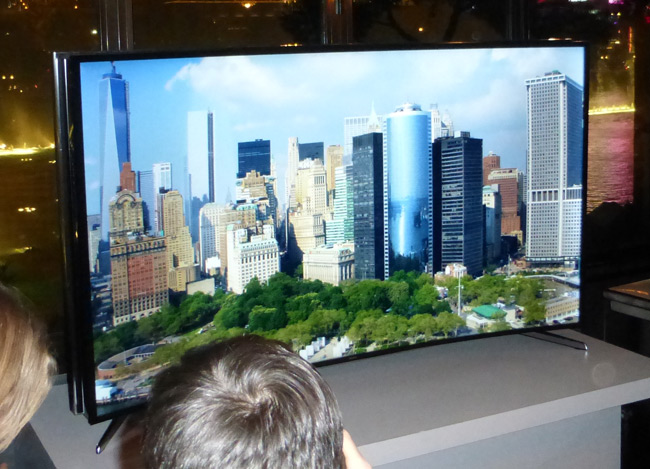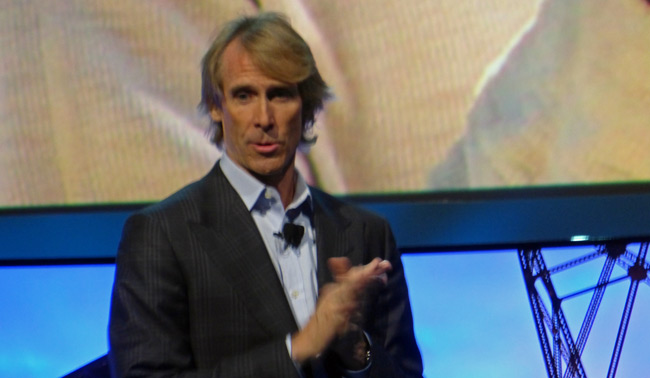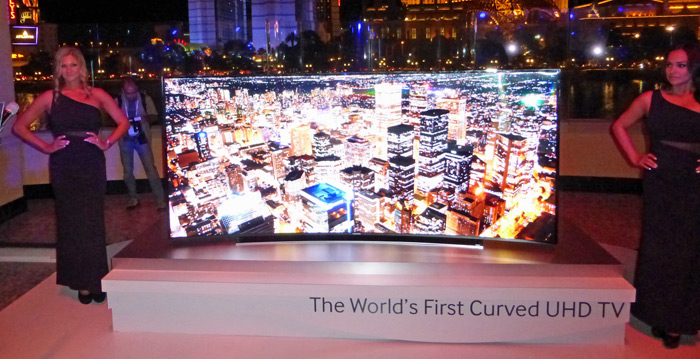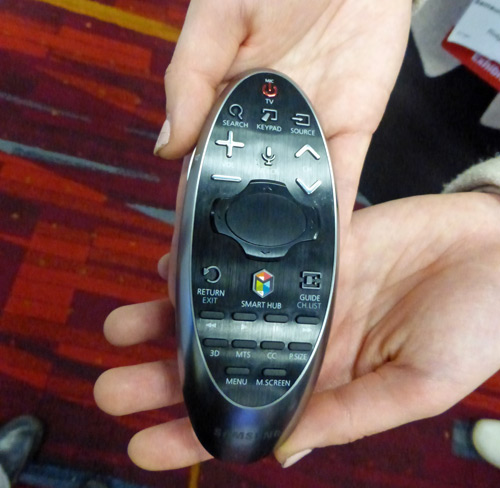Some of the things we see at CES will be available within a few weeks or months while others take their sweet time coming to market. Other products on display never make it past the show floor: statement pieces or prototypes that show what is possible when designers are freed from traditional constraints of budget and careful market analysis. They may never see a production run but they're impressive nonetheless.
Samsung always has a few tricks up their sleeve at CES (and I'm not talking about Michael Bay's awkward appearance at their press conference). The most unusual and impressive sites at Samsung's booth this year are a 105-inch Ultra Widescreen (21:9) Ultra HD TV and a bendable 85-inch Ultra HD TV.
Get Bent
The bendable TV (U9B) allows the customer to choose between it being a fully flat panel or a curved set with a touch of a button on the remote. The set uses fairly traditional LED-lit LCD technology to produce an image, but they've found a way to make the LCD panel and light source flexible enough to bend. It's isn't a radical amount of curve, but it does make for an interesting demo. Pricing was not available at show time, but Samsung does say that they intend to bring it to market in late 2014.


Ultra Wide Ultra HD
The 105-inch Ultra HD (U9500 series) is perhaps more interesting in that it sports an ultra-wide 21:9 aspect ratio: similar in shape to a CinemaScope movie screen. It's actually higher resolution than the standard 16:9 4K TVs due to its wider size. The height is 2160 pixels like most Ultra HD sets, but the width is a whopping 5120 pixels, compared to the 3840 pixel width of 16:9 Ultra HD TVs. To get native content on the set in this format, Samsung used anamorphic squeeze to get the ultrawide content down to 3840x2160 pixels, then stretched it back to its native aspect ratio on the set.

The 105-inch set looked gorgeous with the curve adding to the cinematic effect. If you're wondering why LG and Samsung each announced a 21:9 Ultra HD set in this exact size, it's because both companies are building the same size "motherglass" - the substrate on which the LCD imaging panel is formed. One piece of motherglass is big enough for exactly two 105-inch 21:9 LCD panels. As with the bendable TV, the 105-inch U9500 TV does not yet have a price but Samsung says it intends to release it in late 2014.
New Remote, New Smart Hub
In the slightly more mundane department, Samsung also showed off their new Smart TV user interface and a brand new motion-sensitive remote control that will come standard with all Samsung HD and Ultra HD TVs from the H6400 series and above. The new Smart Hub is really just a tweak of the 2013 Smart TV screens. There are still five panels for things such as TV shows, movies and apps, but they've moved the social apps to a different panel and have added a new games panel that highlights games that are available from Samsung's TV app store. And since games might be hard to play with a standard TV remote control, Samsung has also beefed up their touchpad remote with motion-control capabilities, similar to a Wii remote or LG's Magic Remote. I played around with one in Samsung's suite and it was pretty easy to use and made navigating through the various Smart Hub screens that much simpler.

In addition to motion control, the new remote features DVR playback controls right on the remote. In 2013 DVR playback was only available on the "virtual" remote that you can pop up on screen. Putting these playback controls on the remote itself is a big improvement for those who want to use a single remote for everything TV- and app-related. The smaller (than 2013) touchpad still respnds to gestures for navigation and control, adding standard 4-way buttons around the edges of the roughly circular touch-pad.
Yes, Picture Quality Still Matters
In the picture quality department, Samsung has made several improvements to their sets including bringing back full array backlighting and true local dimming in select LED HDTVs and Ultra HD TVs in 2013 (S9 Series UDTHVs). This improved contrast ratios and black levels as well as image uniformity. But one specific improvement that caught my eye for 2014 was their enhancements to motion reproduction. Always the bane of LCD and LED/LCD TVs, the "sample and hold" method used to display an image on an LCD panel can lead to smeared motion. The typical solution -- motion interpolation -- leads to its own set of artifacts: some feel that it makes movies look more like videos, with unnatural looking motion.
An alternate approach to reducing motion smearing and blurriness is to use something called black frame insertion, or backlight scanning. These approaches dim the backlight between each frame (and in many cases, repeat the frame) in order to cut back on smearing without adding any new motion artifacts. On Samsung's 2014 TVs, Samsung now offers excellent motion reproduction without having to resort to motion interpolation.
On the 2014 Samsung HD and Ultra HD TVs -- H6400 series and above -- owners have independent access to "Auto Motion+" (motion interpolation) and "Clear Motion" (backlight scanning). On a test of a fast moving scan across a newspaper, we could see that the motion was crisp and clear with only the "Clear Motion" feature turned on. And this film-based content was presented on screen at a native multiple of 24 frames per second which maintains that "film-like" look. The setting is called "LED Clear Motion" on the HD TVs and "UHD Clear Motion" on the Ultra HD sets. By default, both AutoMotion+ is engaged in most picture modes, but Clear Motion is off so if this is something you're interested in experimenting with, be sure to dig deep in the picture settings menus.
As far as OLED and plasma TVs, Samsung had nothing new to speak about. With Panasonic exiting from the plasma business, but LG still pledging support for five plasma models in 2014, plasma's future is decidedly up in the air. Samsung reps told us in a briefing that the decision whether or not to continue making plasma TVs has not yet been made. I personally hope they keep it up as Samsung's 2013 plasma TVs (specifically the F8500) was an outstanding performer, earning the highest mark's in the prestigious Flat Panel shootout.
More Information: